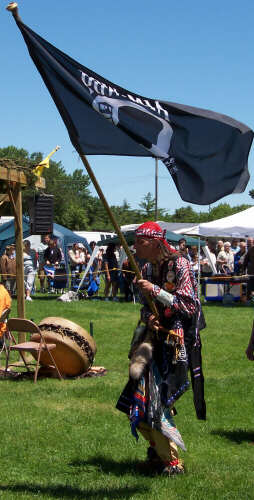|
I am not
personally a practitioner of traditional ways. I try to bring
the philosophies and purposes of custom and ceremonial practices
into some form of expression in my life, but I do not walk a
path of historical ceremonies.
My first experience at a powwow was highly spiritual and very
positive. Yet, I recently read an article quoting an elder
saying people are always trying to make powwows out to be such
spiritual events, when they are actually supposed to be a coming
together in community to just have fun. From an outside
perspective, powwows seem, to me, to be part church, part craft
show, part public performance, and yes, a good bit of fun
dancing and community gathering. Indeed, one thing I do know is
that there are no shortage of opinions (just like elsewhere) in
First Nations communities about how things are done, or what
they mean. Sometimes this stems from varying tribal customs. For
instance, in our area, a dropped Eagle Feather is a faux pas not
to be trivialized, and will bring a strong reprimand about
proper respect. But, I attended a local powwow here one year
where a dancer from a western tribe intentionally dropped an
Eagle Feather. In his tribal customs this was done to honor a
close family member or warrior who had recently died. It caused
a little commotion while things were being worked out, but to
the credit of the hosting elders, both traditions were
ultimately explained to all those present. I have reprinted
(with permission) two excellent articles from John Two-Hawks
Circle of Nations newsletter which I think address and explain
some of this. They are:
‘Pan-Indian’. . . . To be, or not to be . . . . and
‘The
Indian experience’. . . . who is a real Indian?
|
GRAND ENTRY
Each of the powwows I have attended has begun with the
Grand Entry. It is a time of honor and respect as the
flags and banners are brought into the arena and posted.
Flag songs, honor songs, an invocation, a welcome song,
and a veterans song typically fill up the opening times of
each day, or session of the powwow.
Right: Richard Begley carries the POW-MIA flag in
Lansing, MI.
Below top: Grand Entry at the Frank Bush Memorial
"Walk in the Spirit" Pow Wow at Charlton Park in Hastings,
Michigan.
Below bottom: Grand Entry at the Riverbank
Traditional Pow Wow at Louis Adado Riverfront Park in
Lansing, Michigan.
|
|
 |
Powwow dancing described in the Riverbank Traditional Pow Wow
brochure:
American Indian dances are an expression of thankfulness to the
Great Spirit, as the people dance in a sacred circle around the
drums. The circle represents the cycle of life, the moon, sun,
and earth. The drum arbor, which is traditionally covered with
cedar, is in the center. The drums are the heartbeat of the
powwow and of the people who dance. Dancing is done in a
community spirit. It is a time when friends and relatives come
together to celebrate with each other. Over the years, the
dances have changed to reflect the growth of traditions. You
will see two styles of regalia on the dancers. The traditional
dancers use natural items and colors, with designs based on
nature; the fancy dancer use brighter, more eye-catching colors
and materials. While looking at the various dancing outfits,
please remember if you have a questions about a dancers dress,
please ask them. Most dancers have created their regalia
themselves. Native American's do not call their dress
"costumes," these outfits are spiritual significant rather than
just for dress up.
(Click
here for more information)
In
addition to the drum and the dancing, sometimes powwows have
cultural displays or living history exhibits, and, of course,
there are the traders, who according to the Frank Bush Memorial
brochure "have been a fixture in the Pow Wow since the very
first. They are a major part of the circle."
Once in a while I get a "raised eyebrow" type of response in
some conservative Christian circles when I talk about powwows,
and other First Nations topics. However, there is nothing to
preclude a Christian from honoring or participating in these
traditions. The Cherokee significantly embraced Christianity, as
was still evident in the prayer offered at a powwow I attended
in Tahlequah, Oklahoma. Organizations such as Wiconi
International use dancing and drum circles in Christian worship
services and evangelical outreach throughout the world. For more
information on some of these, see their websites listed in the
Christian and Native American links.
+++++++
I
have only taken my camera to a powwow on two occasions. Both
times it was for the express purpose of creating these pages.
There are powwow rules and courtesies to be observed which
include photography (when, and of what, pictures may be taken).
For a person not steeped or well versed in the traditions and
etiquette, yet who is trying to be respectful, a powwow can
offer some very frustrating moments, in spite of best
intentions. But, once you have been to a powwow, somehow,
the drum keeps calling you back.
+++++++
For
more information about powwows, shared within the brochures of
the Frank Bush Memorial "Walk in the Spirit" Pow Wow and the
Riverbank Traditional Pow Wow in Lansing,
click here.
|